Ball Pythons are one of the smallest breeds of python in Africa. These snakes are slow moving and have a stocky body shape. They are also one of the calmest species, making them very popular.
Unlike many snakes, there is a large size difference between males and females.
Males and females are hatched the same size and weight. But, females grow up to 1.5 times faster! This means fully grown female ball pythons can be twice as long as males.
Their size is a big factor in their popularity as it makes them more manageable for keepers.
Read on to learn about their full grown size, growth rates, and how to maintain a great body condition for a healthy snake…
How Big Do Ball Pythons Get?
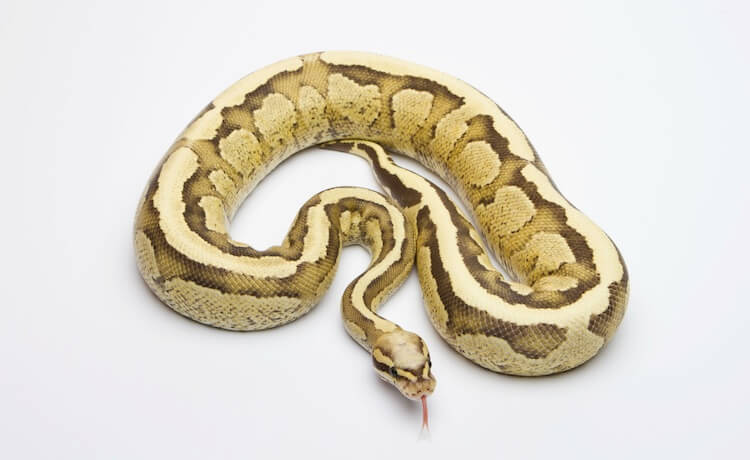
Ball Pythons are thick, stocky snakes that stay relatively short. A fully grown ball python will measure between two to five feet. Their size makes them a great pet for many new owners.
Males are always smaller than females due to sexual dimorphism, they finish growing at the smaller end of the size spectrum. Males are between 2.5 to 3.5 feet long by the time they reach three years old. One study on wild male species found the largest individual was 4.5 feet long, but this is unusual. The smallest measured adult male was only two feet long.
Female Ball Pythons are much larger due to their genetically faster growth rate. Many females are between four to five feet long, some have been measured as large as 6.5 feet! They typically weigh around five pounds (compared to three pounds for males), but this depends on their length. Larger snakes can weigh as much as seven pounds.
Babies hatch at only 10 to 17 inches long. This may seem small, but these hatchlings burst into the world ready to eat their way to adulthood.
Both sexes grow at a nearly identical rate for the first six months, after that females begin to grow roughly 1.5 times faster:
- Males between six months and three years grow at 8 inches per year.
- Females will grow between 12 to 16 inches per year.
When compared to other pet snakes this species is classified as medium-sized.
Ball Pythons have a thick, stocky body shape because of their weight. Adult males are slimmer and weigh between two to three pounds, but females are much heavier and will pack on weight. They have a more rounded, full body. This body condition is directly linked to their ability to produce offspring.
These snakes are sedentary and have a slow metabolism, this makes it easy for them to put on weight quickly. Enclosure enrichment and feeding schedules are important to stop them from becoming obese. Females can become overweight quickly if not monitored.
Weight to Age Chart
The following is a weight to age chart for an average Ball python. Ball pythons grow at different rates depending on how often you feed them. The following is only average and may vary. If you have concerns please seek out a competent vet.
| Age | Male weight in ounces/ pounds | Female weight in ounces/ pounds |
| Hatchling | 1.6-2.8 ounces | 1.76-2.8 |
| 1 month | 2.5-3.5 | 2.8-3.7 |
| 6 months | 9.7-12.69 | 10.58-12.69 |
| 9 months | 14.10-15.87 | 15.87ounces -1lb |
| 1 year | 1.10lbs – 1.76 lbs | 1.4 lbs-1.76 lbs |
| 1 ½ years | 1.32 lbs- 1.98 lbs | 2.2 lbs- 3.08 lbs |
| 2 years | 1.76 lbs-2.42 lbs | 2.64lbs-3.96 lbs |
| 3 years | 1.98 lbs-2.64 lbs | 2.64 lbs-4.40 lbs |
| 4+ years | 1.98 lbs -2.64 lbs | 4.40 lbs -6.61 lbs |
Ball Python Growth Rate
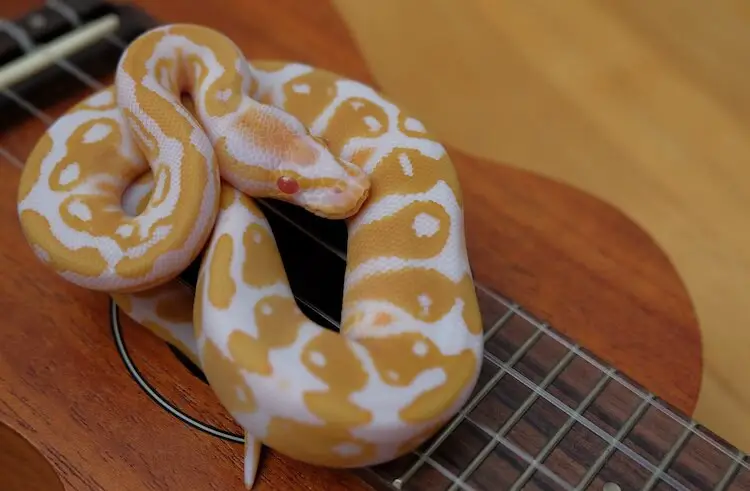
Monitoring your Ball Python’s growth rate will help you determine if your snake is maintaining a healthy size and weight. The growth rate of a snake is calculated by measuring the total size gained within a year, but what does this mean for your pet?
The natural growth rate of a Ball Python is different for males and females. Females have a growth rate of nearly 1.5 times that of the average male.
A female grows at nearly one foot per year for the first four years. After four years her growth will typically slow until it plateaus at around five years old.
On the other hand, males will grow eight inches per year until they reach sexual maturity at three.
Researchers discovered that females are hatched with a higher postnatal growth rate. This means that they start growing faster than males within three months of hatching. As they age this becomes very clear.
How Long Does It Take For A Ball Python To Grow?
All ball pythons are hatched at 10 to 17 inches long. With a consistent feeding schedule, females will reach four to five feet long in five years. Males typically only reach 2.5 to 3.5 feet at the same age. After reaching three, their growth rate slows down considerably.
At roughly three years, females can be up to a foot longer than males. At this point they can also weigh 50% more, females are around 1,500 grams and males lag behind at 900 to 1,100 grams.
Ball Python Growth Chart
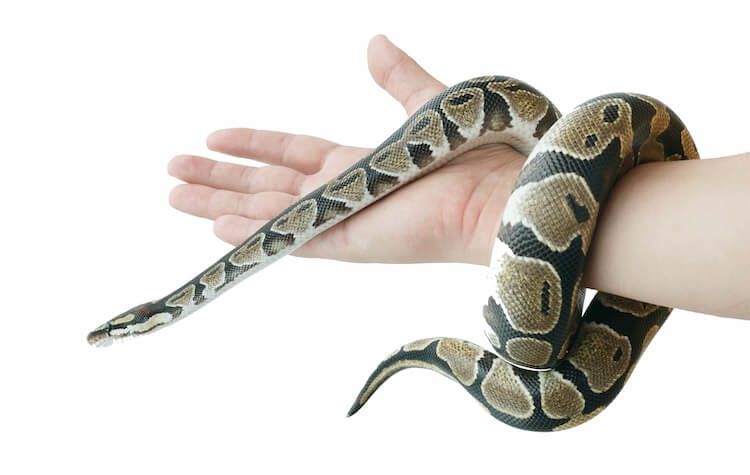
Weighing your snake is very important, especially during the first three years. It will help you to track their growth, keep them within a healthy weight range and stop obesity. If your snake is growing faster than the charts below, make sure your tank setup and husbandry is correct and that your feeding schedule is appropriate for their age.
The lower range of the weight spectrum described by the tables below is typically for males.
Females are often on the higher end, or even exceed it.
As long as your ball python keeps a healthy body condition, it is okay for them to be heavier than normal. Just make sure they do not put on weight too fast and become obese.
A healthy body condition looks at the overall girth (i.e. thickness) of your snake. To judge body condition, lay your snake down with the tail towards you and look at the shape of the thickest part of the body:
- Ideally a ball python should have a rounded, equilateral triangular shape from the spine.
- An overweight snake will have a more obtuse rounded triangle shape.
- Obese snakes have a totally circular or oval shape around the spine.
There are many factors that go into a ball python’s size, but the averages below will help you to gauge their growth rate:
Size By Age
| Age | Male Length | Female Length |
|---|---|---|
| Hatchling | 10 to 17 inches | |
| Six Months | 20 to 27 inches | |
| Nine Months | 25 to 30 inches | 25 to 35 inches |
| One year | 1.5 to 2 feet | 2 feet |
| One and a Half Years | 2 to 2.5 feet | 2 to 3 feet |
| Two Years | 2 to 3 feet | 2.5 to 3.5 feet |
| Three Years | 2.5 to 3.5 feet | 3 to 5 feet |
| Four+ Years | 2.5 to 3.5 feet | 4 to 6 feet |
Weight By Age
| Age | Male Weight (grams) | Female Weight (grams) |
|---|---|---|
| Hatchling | 50 to 80 | |
| One Month | 70 to 100 | 80 to 105 |
| Six Months | 275 to 360 | 300 to 360 |
| Nine Months | 400 to 450 | 450 to 470 |
| One year | 500 to 800 | 650 to 800 |
| One and a Half Years | 600 to 900 | 1000 to 1400 |
| Two Years | 800 to 1100 | 1200 to 1800 |
| Three Years | 900 to 1200 | 1200 to 2000 |
| Four+ Years | 900 to 1200 | 2000 to 3000 |
Feeding Chart by Size
Choosing prey based on the size of your ball python is very important. It is one of the most important things a keeper can do. It will help to ensure your snake has a healthy growth rate and will prevent obesity.
With a routine feeding schedule, and appropriately sized prey, based on your snake’s size and age, you should be able to maintain a healthy body condition.
Juveniles and adults should have more time between feeding. This allows them to grow without gaining too much weight. If you feed your snake at a fast pace, they will grow faster, but they become at risk of becoming overweight. This is termed “Power Feeding” and can shorten their lifespan.
If your snake is on the smaller size, you may need to feed smaller prey items for longer. Females that are being prepared to breed may be fed more.
The diet schedules below outline the best feeding guidelines for your snake using either mice or rats.
Mice
| Snake Size | Mice Size | Schedule |
|---|---|---|
| Hatchling | 1 Fuzzy | Once a week |
| <150 grams | 1 Hopper | Once a week |
| 150 to 350 grams | 1 Small or Medium | Once a Week |
| 350 to 600 grams | 1 Adult | Every 10 Days |
| 600 to 1,000 grams | 1 Jumbo | Every 14 Days |
| 1,000 to 1,500 grams | 2 Jumbo | Every 14 Days |
| 1,500 grams | 3 to 4 Jumbo | Every 21 Days |
Rats
| Snake Size | Rat Size | Schedule |
|---|---|---|
| <150 grams | 1 Fuzzy | Once a week |
| 150 to 350 grams | 1 Pup | Once a Week |
| 350 to 600 grams | 1 Weanling | Every 10 Days |
| 600 to 1,000 grams | 1 Small | Every 14 Days |
| 1,000 to 1,500 grams | 1 Medium | Every 14 Days |
| 1,500 grams | 1 Large | Every 21 Days |
Feeding guidelines can be adjusted depending on the body condition of your snake. To judge this, you need to know the signs of being underweight or overweight.
An underweight Ball Python will have a triangular body shape with a sharp spine shape. They will also seem very active because they are searching for food. If you use the suggested guidelines above, it is very difficult to underfeed your snake.
Obesity is a much larger problem in pet Ball Pythons.
Many keepers misjudge an overweight body shape to be ideal because they are heavy-bodied snakes. An obese snake will normally have scale wrinkling and folding when moving. Their bodies will also feel squishier with bulging around the vent and neck.
Obese snakes also explores less. This creates a revolving cycle; the snake is too big to feel comfortable moving, so it stops exploring and gains more weight.
Factors That Influence Their Size
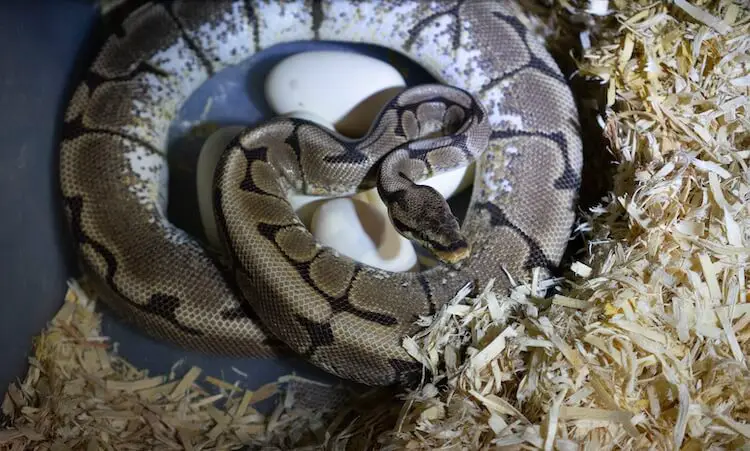
Many full grown ball pythons reach a length between 2 to 5 feet long, but this depends on four key factors:
- Gender
- Husbandry
- Enclosure Size
- Diet
One of the biggest influences on this species’ size is gender. Males, even when fed the same diet as a female, have slower growth rates and stop growing much earlier. Adult females can be twice the size of males!
Husbandry is also another factor in your ball python’s adult size.
A basking area of 88 to 92°F and a proper temperature gradient is essential for metabolizing food. This not only helps them maintain a steady growth rate, but also stimulates activity and prevents obesity.
Husbandry is tied to enclosure size.
Without a proper sized enclosure, it is nearly impossible to create a temperature gradient and give space for your snake to exercise. A 20-gallon tank can work for juveniles, but adults need at least 40-gallons. Some ball python morphs need a 50-gallon tank.
A feeding schedule is also very important, regardless of whether you begin by feeding rats or mice. Feeding mice at a young age can slow down your python’s growth rate, but this helps to maintain a healthy weight. Feeding rat pups will help your snake to gain size quickly at a young age.
Many factors can affect the growth rate and body condition of your snake. It is important to regularly weigh your snake and study their girth to make sure it is within the recommended guidelines.
How To Weigh A Ball Python
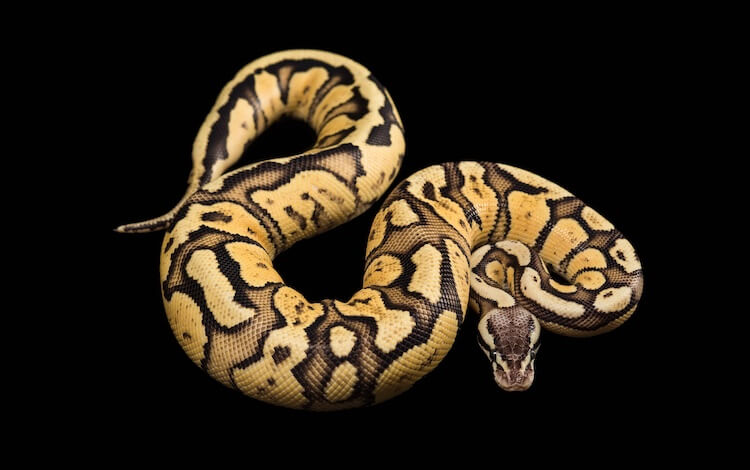
The first step to monitor your snake’s weight is to purchase an appropriate scale. A scale with a platform of at least six inches square should be large enough to accurately weigh this snake.
You will need a scale that is capable of accurately measuring a range of 50 to 6,000 grams. Hatchlings start at 60 to 80 grams and a full grown adult can reach between 1,000 to 3,000 grams (depending on gender). You not only need to account for the snake’s weight, but also the weight of the container.
Many keepers use kitchen scales, which work well. Most kitchen scales come with a bowl that is capable of holding a young snake, but an adult, especially a female, may be hard to fit into these. A plastic tub that is at least 12 inches by 10 inches should be large enough to weigh a coiled adult.
Before weighing your snake, place the container on the scale and zero the weight so that it is not added to the total weight.
Because of the initial stress of being handled, normally ball pythons will ball up when being removed from their enclosure. This is the best time to weigh them, as they won’t move and are relatively small.
A snake who is starting to feel comfortable will move quickly and may try to escape the container.
If your snake happens to want to explore all the time, you can use a Tupperware with a lid. In this case, make sure you place the lid on the dish when you zero the scale.
It may sound like a lot of work, but once you master getting your snake to stay still for a few seconds, weighing them becomes easy.
Summary
Monitoring the growth and size of a ball python is very important. Making sure that your snake is gaining weight, and maintaining a healthy body condition, will lead to an active, healthy and long-lived pet.
Hatchlings of both sexes are born between 10 to 17 inches long.
Males should grow around 8 inches per year, while females grow between 12 to 16 inches each year.
After three years, a male will be full grown and should measure 2.5 to 3.5 feet. At the same age females should be approaching 4.5 feet. By five years, a female can grow as long as six feet, making them twice as big as males.
Gender is the biggest factor in size. Husbandry, enclosure size, power feeding and diet also affect length and body condition.
Whether you have a small, slim male or a long, stocky female, with proper care you can keep your pet for upwards of 30 years. Do you weigh your Ball Python regularly? Let us know how big your snake is in the comments below!

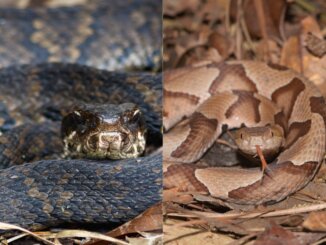
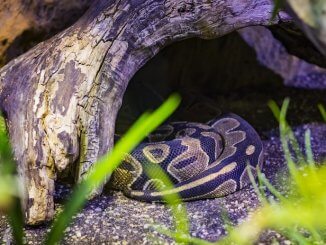
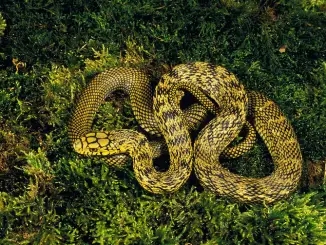
Hi, I was given 2 ball pythons (aprox. 10 years old). I think they need a bigger cage. How big of place do they need?
Hi Lee, typically an adult can be housed in a 30-gallon tank. What is the size of the current cage?
Your article says 40+ for adults. Depends on gender too. If he has two full grown females a 30 would be way too small. Invest in a 40 or even a 75. They’re only around 50 and 120 dollars respectively.
A tank that can hold js about 60 or more gallons
They need between 20 and 40 gallons. Per python.
The adult ball python needs a home that is large enough to fit in comfortably and tall enough to climb. It should be between 40-55 gallons and three to four feet in length. There ideally should be a slight temperature gradient from a warm to a cooler side. Larger environments may make them stressed. It is not recommended to put two ball pythons in the same cage.
a good rule of thumb i use: two adjoined sides of their enclosure should add up to at least the length of your snake, or bigger. not too much bigger.
You will need a 30-40 gallon tank minimum for each python. Never house two together, they could easily get stressed out by each other. They’re solitary animals
They should be in a minimum enclosure size of 4x2x2 (4 feet long, by 2 feet wide, by 2 feet tall)
Hello, we recently got a ball python and I read about the obesity, so I’ve got a question about that. We do notice when we hold him and he coils around he has flaps of skin. But when he’s exploring his cage and moving around, he doesn’t have them. Is he considered obese? The person didn’t know his exact age, but based on the information here, he looks to be 2.5-3 years and they were feeding him weekly.
Hi Rachel,
It is best to judge body condition when you are not holding your snake. After you have finished handling, lay your snake down with the tail facing you. Is your Ball Python circular or triangular around the spine?
Yes snakes can be obese. Generally, if they are too thick around, have “fat wrinkles”, scale separation or a sunken spine, these are signs of being overweight. You can see visible skin between scales and the python will have a more rounded shape. Conversely, a skinny Ball python will have a rigid back, triangular body shape, Hollow belly, head appears larger than body circumference, hanging skin, loss of jaw definition, and sunken in eye sockets. Adult Ball pythons eat once every week or two.
I have a male he is just over 4’. I feed him 5 mice once a month. He seems to be very healthy and active. Does this sound about right?
It all depends on the mice size. But in general, it is best to feed one appropriately sized mouse rather than many small ones. Feeding a mice that is 1 and a quarter times as wide as the widest point of the snake, should be enough food for, at the very least, one week. This is more efficient in terms of calories intake: a given amount of calories divided across three mice will be a way larger item, and thus takes more space and effort to digest, than a meal consisting of one, larger mice.
Hi,
How did you determine the weight by age table please?
Many thanks,
Dani
We just added a chart to our article that you can view now
Hi
I have a one year old banana ball python measured a little bit above 3 feet, and weight 800 grams, his father is a banana (male maker), and his mother is normal.
So my question is if there any chance that my ball python is a female? or just a male that grow fast?
A Banana Ball python is a codominant morph, you only need one Banana Ball Python to produce banana babies. I suggest you check out the video on youtube on “How to Tell If Your Ball Python Is a Male or Female by Popping This” https://youtu.be/eI26REv4MOM to sex your snake. 1.76 pounds is still within the average weight for a year old snake, albeit on the higher side for a male Ball python.
I have a normal BP that I believe to be male. Was a really slow grower until last year and he has shot up. Started 2021 weighing 570g in March. Went on 3 month hunger strike until June and now Feb 2022 weighs 1260g. Eats x1 jumbo mouse every 7-10 days and is approx 3ft 3in in length.
40 gallon is perfect for an adult male unless they are bigger than normal, 55 gallon for female adults unless they are bigger too
Not sure of I have a freak of nature or wrongly sexed male ball python but he’s 4ft at 1.5yrs old and weighs 1100g
His size seems consistent with that of a female. He may be a she. However, we are always talking about average, and you can get all sorts of deviations from the norm: some male Ball Pythons have reached 5 feet so you might just have a larger-than-average snake. Have you sexed it yourself or was it done by a professional?
It was done by a “professional” in the sense he was purchased from a reptile shop. Who probed him. And at the time said definitely a male.
I havnt seen any signs of growing folicals or bowl wrapping this year so would still lean towards male but this is where I’m no longer sure.
I do not feel comfortable probing myself. I wouldn’t forgive myself if I injured one of my snakes.
I see. At this point I’d lean towards male too. A huge one, sure, but not unheard of.
So I was given a ball python about 18 yrs ago she (assuming she do to size) in a 60 gal tank doesn’t eat all the time a jumbo rat once every 6-8 weeks. Weight is 8lbs. She was big when we got her so we are thinking she is 25+ years. Just wanted to share. Thank you.
Also just got a small Ball about 2 years ago that has a blister on it. Is never had a tank heater just a light. The blister is long and covers different parts of her body. I keep getting told it’s a burn by the vet. I know to be wrong cause “no heater” in tank. Any help on this matter will be appreciate. Thank you.
Regarding your younger python, you might be looking at a blister disease, which is not very common but still, an issue for snakes raised in captivity (one your vet should really know about). In most cases it is caused by either high humidity, an unhygienic environment or a combination of the two and might lead to further infections down the line.
You’ve had a snake for 18 years, so you do know how to clean an enclosure and regulate humidity, but perhaps do find a more specialized veterinarian to get him treated. This usually involves some topical antibiotics. Hope this helps.